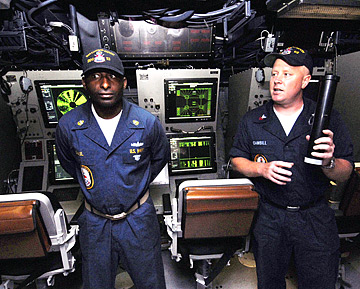Court silences RIMPAC sonar
A U.S. judge shuns the Navy's claims, favoring concerns about whale safety
The largest multinational naval war games in the world will kick off in Hawaiian waters beginning tomorrow, but the U.S. Navy won't be able to accomplish one of its major objectives: training in anti-submarine warfare.
Yesterday, a federal judge barred the Navy from using sonar during the Rim of the Pacific naval war games because it could be harmful to whales and other marine mammals. Unless there are major concessions made by the Navy, the ruling also could jeopardize future multinational naval exercises.
It is a major setback for the Navy, whose leaders have been stressing the importance of using sonar to track quiet diesel submarines. Such submarines are considered the major threat to the U.S. in the Pacific, naval planners say.
All of the submarines in the U.S. fleet are nuclear powered. However, three RIMPAC participants -- Japan, Australia and South Korea -- brought diesel submarines to help U.S. naval warships learn to cope with the threat.

GREGG KAKESAKO / GKAKESAKO@STARBULLETIN.COM
Petty Officers Charles Paul and Paul Gambill, both sonar technicians on the destroyer USS Chung Hoon, take measurements to help technicians better utilize the sonar systems.
|
|
With more than 140 diesel-electric subs belonging to countries like North Korea, China and Iran, Adm. Gary Roughead, commander of the Pacific Fleet, had made it mandatory for U.S. warships to undergo intensive anti-submarine warfare in waters off Oahu before deploying to the western Pacific.
The U.S. Navy has 50 nuclear-powered subs split between the Pacific and the Atlantic, but no diesel subs. The Heritage Foundation has said that China has 70 diesel subs, North Korea 26 and Iran six. They carry torpedoes, cruise missiles and mines, like nuclear subs, and can hide in strategic points in the Taiwan Strait or the Strait of Hormuz in the Middle East, or the Strait of Malacca, operating quietly on battery power.
Yesterday, U.S. District Judge Florence-Marie Cooper in Los Angeles ruled that a national security exemption issued Friday by the Pentagon does not cover the National Environmental Policy Act. The judge's ruling remains in effect until July 18 -- just a week before the war games end.
"This ruling underscores that no one, not even the U.S. military, is above the law," said Joel Reynolds, senior attorney at the Natural Resources Defense Council, which filed a federal lawsuit Wednesday, hoping to block the Navy from using sonar.
Even before yesterday's ruling, the Navy last week acknowledged that other new restrictions placed by the National Oceanic and Atmospheric Administration on where the 35 RIMPAC warships could use active sonar would impact the exercise planned for the rest of July.
This is the first time in the 20-year history of RIMPAC that the Navy was forced to get a permit to use sonar. The permit forbids the Navy and the seven allied countries from using sonar in shallow waters and also requires the warships to lower the power on its sonar systems when it comes in contact with whales, dolphins, and porpoises.
In its lawsuit, the Natural Resources Defense Council said the use of mid-frequency sonar during the RIMPAC 2006 naval exercises posed an unnecessary and avoidable threat to marine mammals and violated two fundamental environmental laws: the Marine Mammal Protection Act (MMPA) and the National Environmental Policy Act (NEPA).
Joel Reynolds, a senior attorney at NRDC and director of its Marine Mammal Protection Project, yesterday said: "Last Friday, the Navy did an end run around the law protecting marine mammals, but fortunately this country has more than one law against the needless infliction of harm to endangered whales and the environment. We sincerely hope the Navy will now choose to comply."
Two years ago, during RIMPAC, sonar was cited as a "plausible, if not likely" cause of the stranding of 150 melon-headed whales in Hanalei Bay on Kauai.
Environmentalists have wanted the Navy to adopt measures establishing a larger, permanent safety zone around mid-frequency sonar sources; adding an extra marine mammal spotter on board ships during all sonar training; reducing the sonar power level at night or at other times when spotters' visibility is compromised; and avoiding areas in or near significant marine mammal habitat, like whale breeding and feeding areas, and migratory routes.

